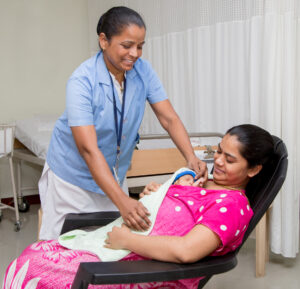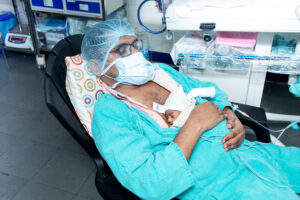
It is natural for mothers to expect sleepless nights after the baby arrives, but there is often little preparation for the sleeplessness that comes with pregnancy. Pregnant mothers frequently find themselves incapable of getting quality sleep, which leaves them feeling fatigued and frustrated. Lack of sleep can have adverse effects on the body and mind and in some cases, cause complications. Sleep disorders like obstructive sleep apnea, restless legs syndrome, and gastroesophageal reflux disorder during pregnancy can be managed with the guidance of your doctor. It may also be helpful to try these 5 tips to improve your quality of sleep:
-
Find A Comfortable Sleeping Position
Finding a comfortable position to sleep in can be challenging as you adjust to your growing bump. You can opt for a pillow between your knees and try out a few recommended positions to see what is comfortable for you. Make sure to keep your hands above the belly to avoid cramping.
-
Maintain Good Sleep Hygiene
Sleep hygiene refers to building habits that ensure you have good quality sleep.
- Go to bed at the same time each night and schedule naps earlier in the day so they don’t interfere with nighttime sleep.
- Make sure your bedroom is quiet, dark, relaxing, and at a comfortable temperature.
- Remove electronic devices, such as TVs, computers, and smartphones, from the bedroom and try to read a book, take a bath, or indulge in other calming activities.
- Avoid large meals before bedtime.
- Get some exercise. Being physically active during the day can help you fall asleep more easily at night.
-
Good Nutrition Goes a Long Way
During gestation, your digestive system slows down. You might have to deal with issues such as heartburn, constipation, or indigestion. Healthy digestion can help get a good night’s sleep.
Keep in mind the following things…
- Cut down on caffeine; not only is it a stimulant that disrupts sleep but is also harmful to your baby.
- Avoid spicy foods, carbonated drinks, citrus fruits that can cause acid reflux.
- Have small meals throughout the day to avoid feeling bloated.
- Do not eat three to four hours before bedtime.
- Take plenty of fluids throughout the day but reduce intake before bedtime.
-
Breathe
Breathing exercises will help you sleep through the night.
- Use humidifiers; they help ease nasal congestion.
- If you suffer from sleep apnea, consider using a CPAP machine, if your physician prescribes it.
- Sleep in an inclined position by raising the height of the pillow.
-
Keep Cramps at Bay
Though leg cramps or restless leg syndrome is hard to prevent, there are ways to soothe cramps
- Exercise during the daytime.
- Include calcium-rich foods.
- Indulge in soothing massage and leg stretches before hitting the bed.
Continued or chronic loss of sleep can lead to gestational diabetes, stress, and depression. If the sleep disorders are difficult to manage, check in with your doctor or childbirth educator at your next prenatal appointment. Have a positive mindset and try meditation and calming activities to keep stress at bay.


